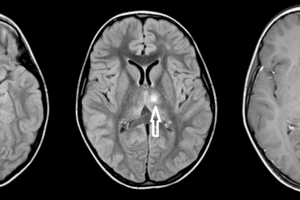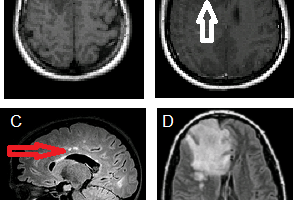Miller Fisher Syndrome (MFS) is thought to be a variant of Guillain-Barre Syndrome (GBS) that affects primarily cranial nerves.
Clinical Presentation of Miller Fisher Syndrome
MFS is an autoimmune disorder that most frequently presents after an antecedent infection. Like GBS, the most common associated infection is Campylobacter jejuni, but it can also occur after viral infections like CMV or EBV, or bacterial infections like strep pyogenes. While there is a case report of MFS developing less than a week after flu vaccine (Blanco-Marchite et al., 2008), there is no large study that we know of linking flu vaccination to cases of Miller Fisher Syndrome.
Patients typically present with the triad of ophthalmoplegia (external, sparing the pupillary reflexes), cerebellar ataxia and arreflexia. The disorder can progress to include other neurological deficits including dysphagia, dysphonia and respiratory distress.
As in GBS, CSF shows cell-protein dissociation (higher protein levels than expected from the cell count). The additional finding of anti-GQ1b antibodies solidifies the diagnosis; about 90% of patients with Miller Fisher Syndrome are anti-GQ1b antibody positive..
Pathophysiology of Miller-Fisher Syndrome
MFS has an unusual connection to other disorders. Because it presents with arreflexia, CSF cell-protein dissociation, and has an association with recent infection, it is consider a variant of Guillain Barr Syndrome. However Miller Fisher Syndrome is also thought of as part of a continuum with the other anti-GQ1b antibody disease, Bickerstaff brainstem encephalitis (BBE). Oddly enough though, BBE and GBS are considered unrelated.
Anti-GQ1b antibodies preferentially affect the optic nerve and cranial nerves 3, 4 and 6 because these nerves have high concentrations of GQ1b gangliosides at their Nodes of Ranvier. The first report of anti-ganglioside auto-antibodies was against cerebellar neurons (Gregson et al., 1977), so it is not surprising that patients present with cerebellar ataxia.
Treatment of Miller Fisher Syndrome
In theory Miller Fisher Syndrome is self-limiting, assuming it does not kill the patient due to respiratory involvement. In practice, however, it is treated like GBS, with IVIg or plasmapheresis as the preferred modes of therapy.
References
- Blanco-Marchite CI, Buznego-Suárez L, Fagúndez-Vargas MA, Méndez-Llatas M, Pozo-Martos P. (2008) Miller Fisher syndrome, internal and external ophthalmoplegia after flu vaccination. Arch Soc Esp Oftalmol. 2008 Jul;83(7):433-5.
- Gregson NA, Pytharas M, Leibowitz S. (1977) The reactivity of anti-ganglioside antiserum with isolated cerebellar cells. Biochem Soc Trans. 1977;5(1):174-5.


